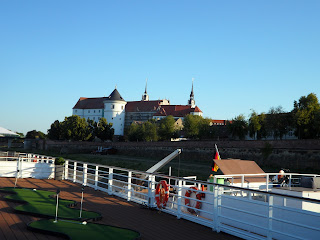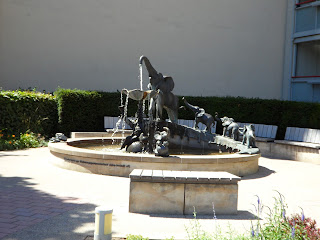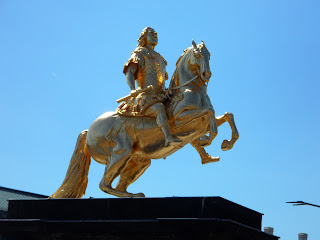We'd been interested in visiting Dresden ever since seeing a special about the rebuilding of the Frauenkirche, which was almost totally destroyed, along with most of the city, during WWII.
Setting out from the boat on foot, we walked along Brühl's Terrace, set between the river Elbe and the Old Town. Also nicknamed “The Balcony of Europe”, the terraced promenade was part of Dresden’s original rampart, until it became the garden of the Royal Palace. It is lined by some of Dresden’s most beautiful historic buildings, including the Royal Art Academy and the Albertinium Museum.

The Procession of Princes (Fürstenzug) is the largest porcelain mural in the world, depicting a parade of Saxonian princes and dukes to commemorate the 1000-year long reign of the Wettin dynasty. 330 feet long and made out of 25,000 tiles from the porcelain manufacturer Meissen, the mural covers the exterior of the Royal Mews in Auguststrasse.
The Zwinger Palace is one of the finest examples of late Baroque architecture in Germany. Built between 1710 and 1728, the Zwinger was used for court festivities and tournaments. Today, the Baroque complex of pavilions, galleries and inner courtyards is home to first-class museums. Here's the courtyard (check out our local tour guide in the foreground, complete with her "lollipop".
Then, the Frauenkirche. Dresden’s Church of Our Lady has a moving history: In World War II, when air-raids wiped out the city center, the grand church collapsed into a 42 feet high pile of rubble. The ruins were left untouched until 1994, when the painstaking reconstruction of the church began. Almost completely financed by private donations from around the world, the people of Dresden could celebrate the resurrection of their Frauenkirche in 2005.


Once away from the historic city center, one can cross the Elbe River and enter a newer part of town. This area contains shopping and plenty of Soviet-era apartment blocks. The blocks are not the best-looking buildings, although since the reunification of Germany, people have tried to make them more presentable. Many of the apartment blocks are owned by the city and used for low-income housing. The apartments are all the same, and our guides, some of whom grew up in the buildings, tell us that they are cramped and very poorly ventilated. The city's circus building, damaged during the war, was replaced by apartments. A fountain commemorates the circus:
The Golden Rider...Augustus the Strong. Now a major landmark.
A story from one of our guides. Being out from under Soviet rule took some getting used to. Under the Soviets, many things were not readily available, but were smuggled in. This included money (once the family received money that had been placed inside a block of butter by a relative) and many food items. Smuggled bananas (considered an exotic and rare treat) and other items were passed from shopkeepers, literally "under the counter", to friends and relatives. At reunification, our guide, who had never been outside the Eastern bloc, went to a "western" greengrocer. She asked the salesperson if they had any bananas. "Why of course" was the reply. Our guide asked how many she could buy. When the salesperson said "as many as you want! Your heart's desire!" our guide almost fainted dead away. She'd never heard of such a thing.
From Dresden, we headed upriver again toward Meissen.



















































